Easy Ways to Redo Bathroom Countertops
Bathroom countertops often bear the brunt of daily wear and tear. From watermarks and soap scum to scratches and stains, these surfaces can quickly lose their luster, impacting the overall aesthetic of the bathroom. Fortunately, a complete remodel is not always necessary. Several cost-effective and straightforward methods exist to refresh and revitalize bathroom countertops, extending their lifespan and enhancing the room's appearance.
The choice of method depends largely on the existing countertop material, the desired aesthetic, and the budget allocated for the project. Options range from simple cleaning and sealing to more involved processes like refinishing or overlaying with new materials. Prior to embarking on any project, a thorough assessment of the countertop's condition is crucial. Identifying existing damage, such as cracks, chips, or deep stains, will inform the selection of the most appropriate red0 method.
Proper preparation is paramount, regardless of the chosen approach. This typically involves cleaning the countertop thoroughly with a degreasing cleaner to remove any dirt, grime, or residue. Repairing any minor damage, such as filling small chips or cracks, may also be necessary to ensure a smooth and uniform surface for the subsequent red0 process. Taking the time to prepare the surface adequately will significantly improve the final result and the longevity of the updated countertop.
Cleaning and Sealing Existing Countertops
For countertops in relatively good condition, a deep cleaning and resealing may be sufficient to restore their original beauty. This approach is particularly effective for natural stone countertops like granite or marble, which can become dull over time due to the penetration of water and other substances. A specialized stone cleaner designed for the specific material should be used to avoid damaging the surface. Follow the manufacturer's instructions carefully, and ensure that the cleaner is thoroughly rinsed off after application.
Once the countertop is clean and dry, a sealant should be applied to protect it from future stains and water damage. The type of sealant will depend on the countertop material. Natural stone countertops require a penetrating sealant that seeps into the pores of the stone, while other materials may benefit from a surface sealant that forms a protective layer. Apply the sealant evenly, following the manufacturer's instructions, and allow it to cure completely before using the countertop.
Regular cleaning and resealing, typically once or twice a year, can help to maintain the appearance of natural stone countertops and prevent the need for more extensive red0 in the future. This preventative maintenance is a cost-effective way to extend the lifespan of the countertop and preserve its beauty.
Refinishing Laminate Countertops
Laminate countertops are a popular, budget-friendly option, but they can be susceptible to scratches, stains, and wear over time. Refinishing a laminate countertop can be a cost-effective way to give it a new lease on life. This process typically involves sanding the surface to create a smooth base, applying a primer, and then painting with a specialized paint designed for laminate surfaces.
Sanding is a crucial step in the refinishing process. It helps to remove any existing imperfections and create a textured surface that the primer can adhere to. Use a fine-grit sandpaper and sand lightly, being careful not to sand through the laminate layer. After sanding, clean the surface thoroughly to remove any dust or debris.
Apply a primer specifically designed for laminate surfaces. This will help the paint adhere properly and prevent peeling or chipping. Allow the primer to dry completely before applying the paint. Choose a high-quality paint that is durable and resistant to scratches and stains. Apply several thin coats of paint, allowing each coat to dry completely before applying the next. This will help to ensure a smooth, even finish.
Consider applying a clear coat over the painted surface to add an extra layer of protection and enhance the durability of the finish. This is particularly important for countertops that are subjected to frequent use and exposure to water. Choose a clear coat that is compatible with the paint used and follow the manufacturer's instructions carefully.
Applying Epoxy Resin
Epoxy resin is a versatile material that can be used to create a durable, seamless, and visually appealing countertop surface. It is a popular choice for those seeking a modern and unique look. Epoxy resin can be poured over existing countertops, creating a new surface that is resistant to scratches, stains, and heat. It can also be customized with various pigments, glitter, and other decorative elements to create a truly one-of-a-kind countertop.
Before applying epoxy resin, ensure that the existing countertop is clean, dry, and free of any loose debris. Any existing damage, such as cracks or chips, should be repaired before proceeding. It is also recommended to sand the surface lightly to create a better bond for the epoxy resin.
Follow the manufacturer's instructions carefully when mixing the epoxy resin. The correct ratio of resin to hardener is crucial for proper curing and durability. Once the epoxy is mixed, pour it evenly over the countertop surface. Use a squeegee or other spreading tool to distribute the epoxy evenly and remove any air bubbles. A heat gun can also be used to remove air bubbles.
Allow the epoxy resin to cure completely according to the manufacturer's instructions. This typically takes 24-72 hours. During the curing process, it is important to protect the countertop from dust and other contaminants. Once the epoxy is fully cured, it will create a durable, seamless, and beautiful countertop surface.
Overlaying with New Materials
For countertops that are severely damaged or simply outdated, overlaying with new materials can be a viable option. This involves installing a thin layer of new material over the existing countertop, creating a fresh and updated look without the expense and disruption of a complete replacement. Several materials are suitable for overlaying, including tile, concrete, and engineered stone.
Tile is a popular choice for bathroom countertops due to its durability, water resistance, and wide range of styles and colors. When overlaying with tile, it is important to choose a tile that is suitable for countertop use, such as porcelain or ceramic tile. The existing countertop surface must be clean, level, and structurally sound. Apply a thin-set mortar to the existing countertop and then set the tiles in place. Grout the tiles and seal the grout to prevent water damage.
Concrete is another option for overlaying bathroom countertops. Concrete overlays can be applied in thin layers, creating a seamless and modern look. Concrete can be stained or colored to create a variety of different aesthetics. When overlaying with concrete, it is important to prepare the existing countertop surface properly and use a concrete mix that is specifically designed for overlays. Seal the concrete overlay to protect it from stains and water damage.
Engineered stone, such as quartz or solid surface, is a durable and low-maintenance option for overlaying bathroom countertops. These materials are non-porous and resistant to stains, scratches, and heat. Engineered stone overlays can be custom-fabricated to fit the existing countertop and installed with adhesives. This creates a seamless and durable countertop surface.
Painting Countertops
While not as durable as other choices, painting countertops is an inexpensive and quick way to update a bathroom's look. It is a budget-friendly option suitable for countertops in generally good condition that require purely aesthetic improvement and who want to learn from experience and ready to re-apply in the future if needed.
Thorough preparation is key to a successful paint job. The countertop should be cleaned meticulously to remove all traces of grease, grime, or soap residue. Sanding the surface lightly will also create a better key for the paint to adhere to. For laminate surfaces, a bonding primer can often be used to prevent the paint from peeling, but it is essential to consider the risks associated.
Several coats of a durable epoxy paint are recommended, allowing each coat to fully dry before applying the next one. Consider using a sealant or clear coat as a final layer of protection against moisture and wear. While this procedure may not offer longevity like other options, it will give a chance to re-do with other material.

Paint Bathroom Vanity Countertop Sink So Easy A Piece Of Rainbow

Paint Bathroom Vanity Countertop Sink So Easy A Piece Of Rainbow

Paint Bathroom Vanity Countertop Sink So Easy A Piece Of Rainbow

Small Bathroom Makeover Painting Countertops Before After Series Ep 8

How To Paint Your Countertops Update A Bathroom We Do

Painting Bathroom Countertop No

Simple Easy Faux Granite Countertops The Stonybrook House

How To Easily Spray Paint Bathroom Countertops My Homier Home

I Chalk Painted My Countertops Lolly Jane

Diy Marble Countertops How You Can Achieve Beautiful Faux Kitchen Or Bathroom Counters Project Our Home
Related Posts







